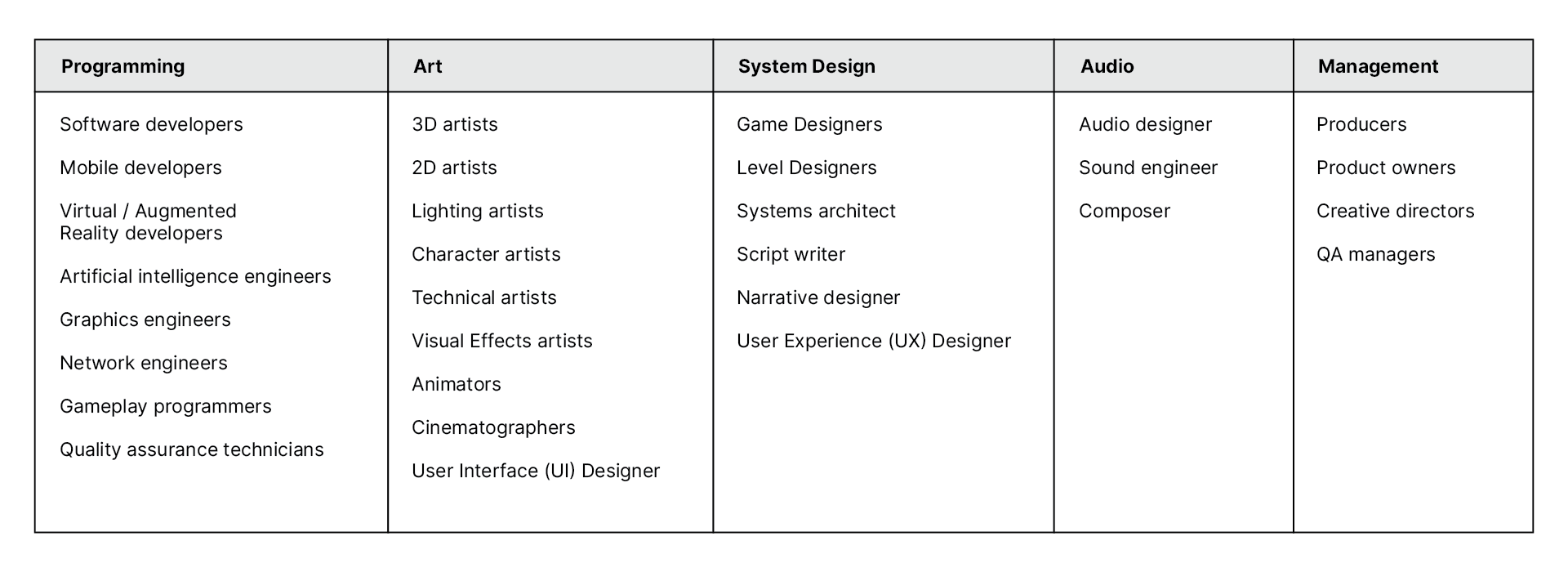Game Development
Production process
Pre-production
- studios produce a design document; a single source of truth for its creative direction (for a film, this would be roughly adjacent to a script or storyboard)
- includes information about the story, gameplay, art direction, intended target audience and accessibility.
- purpose is to iterate quickly while costs to do so are low. This is no different than designing a website mocks/designs/user testing before actually building the website.
Production
Roles involved in production (overseen by the Producer):

Post-production
project is evaluated, edited, polished, and fixed.
- includes alpha and beta testing
Development team
Designer
- conceives of gameplay and the structure/rules of the game
- often the main visionary of the game
- One of the roles of a designer is being a writer, often employed part-time to conceive game's narrative, dialogue, commentary, cutscene narrative, journals, video game packaging content, hint system, etc.
- they are responsible for various parts of the game, such as, game mechanics, user interface, characters, dialogue, graphics, etc
Artist
- designs video game art
- An artists work may be 2d oriented or 3D oriented
- 2D artists may produce concept art, sprites, textures, environmental backdrops or terrain images, and user interface. 3D artists may produce models or meshes, animation, 3D environment, and cinematics. Artists sometimes occupy both roles.
Programmer
The programmer develops video games or related software (such as game development tools).
Individual programming disciplines roles include:
- Physics – the programming of the game engine, including simulating physics, collision, object movement, etc.;
- AI – producing computer agents using game AI techniques, such as scripting, planning, rule-based decisions, etc.
- Graphics – the managing of graphical content utilization and memory considerations; the production of graphics engine, integration of models, textures to work along the physics engine.
- Sound – integration of music, speech, effect sounds into the proper locations and times.
- Gameplay – implementation of various games rules and features (sometimes called a generalist);
- Scripting – development and maintenance of high-level command system for various in-game tasks, such as AI, level editor triggers, etc.
- UI – production of user interface elements, like option menus, HUDs, help and feedback systems, etc.
- Input processing – processing and compatibility correlation of various input devices, such as keyboard, mouse, gamepad, etc.
- Network communications – the managing of data inputs and outputs for local and internet gameplay.
- Game tools – the production of tools to accompany the development of the game, especially for designers and scripters.
Level designer
- a person who creates levels, challenges or missions for video games using a specific set of programs. These programs may be commonly available commercial 3D or 2D design programs, or specially designed and tailored level editors made for a specific game (like Wowedit)
Domain
As far as the actual development of the game goes, there are 2 main routes: programming and designing.
Design
- 3D artist: create 3D objects and backgrounds; optimize graphics performance
- 2D artist: create 2D objects and backgrounds; optimize graphics performance; create storyboards and concept images
- Lighting artist: develop optimized lighting effects; create post-processing effects such as bloom, ambient occlusion, depth of field, and color correction
- Audio designer: create and implement sound effects, voice overs, and music
- Character artist: sculpt and model characters and their assets such as hair, accessories, armor, and weapons
- Technical artist: work with artists and programmers to implement their work within the final product
- Visual Effects artist: create realistic and stylized visual effects, such as lava, smoke, and fire; implement physical properties such as collisions and falling
- Animator: create and optimize high-quality animation of all moving characters and objects; ensure that lighting and visual effects operate well in motion
- Game / Level Designer: construct and implement gameplay; conduct playtesting and implement feedback; validate playability with the testers, level artists, and gameplay programmers
Programming
- Quality assurance technician: find and report bugs; write test cases and plans
- Programmer analyst: write code based on documented design; modify applications to maintain functionality
- C# developer: develop new features and applications; manage the release of products
- Unity engineer: develop new features and applications using Unity
- Research engineer: design, implement, analyze, and optimize state-of-the-art algorithms
- Software developer: design, develop, test, and release new features and tools
- VR / AR developer: prototype and build next generation VR/AR products; deploy and maintain VR/AR applications; stay current on the latest trends in VR/AR
- Mobile developer: develop new mobile features and applications; stay current on mobile technologies
- UI / interface programmer: code user interfaces to meet the intent of the project's design and flow; integrate UI systems into features
- Gameplay programmer: analyze and understand the game design documents; develop gameplay systems such player’s action, character’s behavior, game elements, and game progression
Only top 20 percentile of games make profit